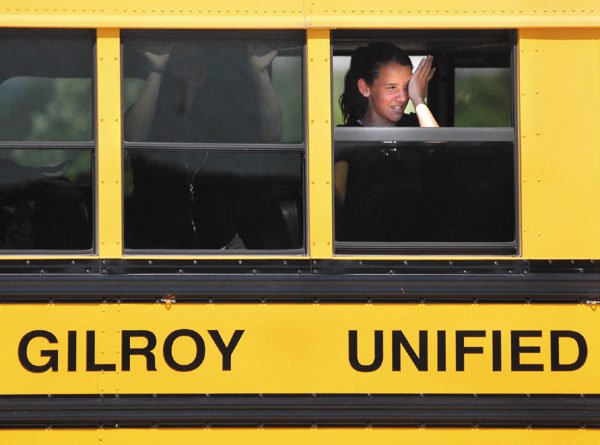Solorsano will be loosening its belt this summer, in part
because more than 60 students have chosen to go there during the
past two years instead of to its struggling peers, South Valley and
Brownell middle schools.
Gilroy – Solorsano will be loosening its belt this summer, in part because more than 60 students have chosen to go there during the past two years instead of to its struggling peers, South Valley and Brownell middle schools.
The students and their families are taking advantage of federal No Child Left Behind legislation, which allows students assigned to schools in program improvement, such as Brownell and South Valley, to attend schools not in “program improvement,” such as Ascencion Solorsano Middle School. Program improvement is a designation for schools that do not meet testing expectations. To accommodate the additional students the legislation has added to Solorsano, four new portable classrooms will be installed this summer.
“In terms of space right now, we’re crowded,” said Solorsano Principal Sal Tomasello. “Choir is actually on the stage in the multipurpose room. Everything else is being used.”
The district will add four portables this summer to the school – constructed in 2003 – easing the squeeze caused by the student influx. While adding portables can be expensive, the district has been creative, taking portable units from Las Animas Elementary School – which closes at the end of this school year.
The portables will come in handy, especially if Solorsano has additional students transfer from the other middle schools in the fall, Tomasello said.
“Of course, if we do get 30 (students), 35, whatever – it’ll help us out,” he said.
In addition to the costs of moving the portables, the district is spending about $15,000 – or $1,000 per student – to bus each of the roughly 15 students that transferred to Solorsano and live more than two miles away.
The students gather at Rod Kelley, Antonio del Buono or Luigi Aprea elementary schools – the pick-up points for the other two middle schools. Because students are concentrated at these places, Solorsano bus routes – which incorporate rural areas such as near Pacheco Pass – are not greatly affected, said Darren Salo, director of district transportation.
“We have the country buses pick up on their way in,” he said. “So it’s not a huge inconvenience.”
The issue should be addressed because the students leaving South Valley and Brownell could be valuable to those schools, said trustee Javier Aguirre. Students most likely to transfer to Solorsano – an academically stronger school, according to test scores – are likely to be near the top of their class.
“You have students (going to Solorsano) who can be role models and can provide significant contributions at the other schools,” he said.
In addition to losing role models and students who would score high on tests, the program improvement schools are missing out on funding. The district’s money is portioned out to schools according to enrollment. This means that as more students transfer to Solorsano, it receives a larger share, while Brownell and South Valley – which are losing students – see their budgets dwindle.
The board has not introduced a resolution aimed at reducing these transfer students. However, at a May 3 board meeting, it directed district staff and principals at program improvement schools to submit information about what strategies they had and what resources they would need to shake off the designation. Brownell is in its second year of program improvement and South Valley is in its third. If the schools stay in program improvement for four years, the district risks having to replace most of the staff, cede partial control of the school to the state or contract an outside entity to manage the school.
Bringing schools out of program improvement would eliminate the mechanism that allows students to transfer to Solorsano and prevent further overcrowding at the school.
The end goal is larger than improving test scores or reducing district costs – it’s about restoring faith in the other middle schools, said Aguirre.
“I’m hoping that parents and students give Brownell and South Valley an attempt to give them an education.”













